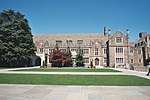J. Deryl Hart House
Duke University campusHouses completed in 1934Houses in Durham, North CarolinaOfficial residences in the United StatesTudor Revival architecture in North Carolina ... and 2 more
University and college residential buildingsUniversity president residences

The J. Deryl Hart House is the official residence for the President of Duke University in Durham, North Carolina. Built between 1933 and 1934 for Julian Deryl Hart, the three-story brick and timber Tudor Revival mansion is located on the university's West Campus, near Wallace Wade Stadium, at the crossroads of Duke University Road and Academy Road.
Excerpt from the Wikipedia article J. Deryl Hart House (License: CC BY-SA 3.0, Authors, Images).J. Deryl Hart House
Duke University Road, Durham
Geographical coordinates (GPS) Address Nearby Places Show on map
Geographical coordinates (GPS)
| Latitude | Longitude |
|---|---|
| N 35.99261 ° | E -78.94065 ° |
Address
Hart House
Duke University Road 2234
27705 Durham
North Carolina, United States
Open on Google Maps









